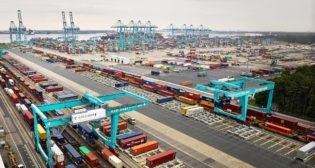
CSX, STB and “confusion to the enemy”
Written by Frank N. Wilner, Capitol Hill Contributing EditorAt CSX over the past 12 months, there has been a series of tumultuous events infusing investors with paroxysms of “what next” worry and propelling the stock price on a roller coaster ride*:
• An investor shake-up of the board and departure of President and CEO Michael J. Ward.
• Recruitment of North America’s most controversial CEO, septuagenarian E. Hunter Harrison, with a mandate to implement his storied Precision Scheduled Railroading so successful at Illinois Central, Canadian National and Canadian Pacific. It had never been attempted on a railroad so spaghetti-like as CSX. Harrison died unexpectedly during a rowdy transformation, further agitated by his cashiering of many experienced officers and furloughing of more than 4,000 workers.
• A payout by CSX of more than $150 million as part of Harrison’s recruitment package – most of it to him, but also to activist hedge fund Mantle Ridge.
• A rail service collapse, following Harrison’s arrival, so severe that Congress took note and shippers compared it to prior post-merger meltdowns.
• Installation, following Harrison’s untimely death, of Harrison disciple and confidant James M. Foote, whose well-respected four-decade rail background is primarily in marketing, sales, investor relations, labor relations, and communications and law. Foote, however, brought aboard as his operations chief, Edmund L. Harris, another former Harrison confidant and assiduous student of Harrison’s Precision Scheduled Railroading.
• Assurances to the STB from Foote in early January that the distressed transition to Precision Scheduled Railroading was showing “a remarkable rate of positive change,” notwithstanding customer protestations to the contrary.
• And comes now, in the midst of this turmoil, reports of CSX freight rate increases, otherwise unattainable absent the existence of captive shippers; and a report that it is reviewing a plan to sell almost 40% of its 21,000-mile railroad (some 8,000 miles). STB officials say they were not informed prior to media reports. CSX denies it is 40%, but does not provide a number other than saying it has “put forth two rail segments near-term for a potential transaction” and “continues to evaluate its network [and] will likely identify non-core segments of the network (see CSX statement at the end of this blog).
• The line sales presumably would be to existing Class II and Class III railroads, and to equity investors who would create new small railroads.
(There currently are seven Class I railroads, including CSX, which have annual revenue of at least $447.6 million; 21 Class II railroads, whose annual revenue is between $35.8 million and $447.6 million, and 546 Class III railroads whose annual revenue is below $35.8 million. CSX’s annual revenue is $10.7 billion, slightly more than Norfolk Southern and below the almost $20 billion of the largest Class I railroad, Union Pacific.)
Failure to have communicated to the STB its review of such extensive line sales is enquiringly troubling, not so much that the STB has oversight of such sales, but because the STB instructed CSX to provide detailed updates on restoration of reliable service, including the current state and resilience of its rail network. A Jan. 3, 2018, Foote-signed CSX update to the STB said CSX does “not foresee any significant operating changes at this time.”
Perhaps CSX has advance and credible knowledge of pending White House nominations to the three vacant seats on the Surface Transportation Board (STB), providing it brazen confidence of a laissez-faire regulatory environment.
Allegations of regulatory capture were persistent during the 1980s following partial economic deregulation of railroads. The late Carl Bagge, when president of the National Coal Association, called STB predecessor Interstate Commerce Commission (ICC) a “wholly-owned subsidiary of the Association of American Railroads.”
Perchance, Foote is trapped in that era. Before emigrating to Canadian railroading, he was an Illinois Central Railroad officer when the ICC was steered by a so-called “gang of three” deregulation purists – Republicans Frederic Andre, Heather Gradison and Malcolm M.B. Sterrett. Then-Burlington Northern Railroad Chairman Walter A. Drexel was so alarmed at the pace by which shipper protections were being dismantled – “excessive and unwarranted,” he said – that he feared a reregulation backlash by Congress.
Wherefore art thou, STB?
Just possibly, Foote and his legal team are risk takers, and the odds may well be on their side. Indeed, the STB’s tepid – in shipper eyes – response to the CSX service calamity consisted of a public hearing at which Harrison spoke, unspecified warnings should improvements not occur, and a demand for written reports.
Captive shippers – those lacking effective transportation alternatives to rail, and thus subject to railroad market-power abuse – who previously spent millions of dollars in congressional PAC contributions seeking regulatory reform, and millions more seeking redress before the ICC and STB, could be on the verge of a new campaign seeking what railroads consider “reregulation.”
Captive shippers are becoming increasingly unsettled. They have ceased filing freight-rate complaints with the STB. They say that notwithstanding prior STB-ordered reparations, they are minimal, and the cost of recovery is excessive. A recent rate challenge by Consumers Energy, asserting rail rates exceeding 500% of variable costs – market dominance is assumed at 180% – resulted in a STB decision reducing that percentage into the 400s, rather than the 200s the utility sought.
In the 2015 Surface Transportation Board Reauthorization Act, Congress directed the STB to work toward developing a less expensive alternative to its Stand-Alone Cost (SAC) test for determining rate reasonableness. A SAC case requires that a shipper spend years and millions of dollars designing an elaborate, hypothetical railroad for cost comparison purposes. So far, the STB’s review efforts consist of a consultant’s report prepared two years ago that was sent to paper recycling.
Curiously, in the most recent Consumers Energy rate case, where the SAC test was used, the STB’s two current board members, Acting Chairman Ann Begeman and Deb Miller, wrote separate expressions criticizing the cost and complexity of the SAC. Yet in 12 months since Begeman became acting chairman, she has failed to follow through on that 2015 congressional directive. In fact, there are multiple other rulemakings sought by captive shippers that are languishing at the board, some since 2014.
Begeman and Miller told Congress, in a quarterly report of STB activities, that they are awaiting nomination and Senate confirmation of new members to fill the three empty seats. There is, however, no quorum requirement in the STB statute, meaning Begeman and Miller could have – or could now – move stalled cases forward.
And this returns us to the CSX gambit of raising rates on captive shippers amidst service failures, and overlooking notifying the STB of its consideration of a major restructuring of its railroad. A recent shipper survey reported CSX service as worst among Class I railroads, yet CSX raising its freight rates more aggressively than other railroads, leading to new shipper allegations of market-power abuse.
As for the line sales, how significant would an 8,000-mile reduction in CSX’s 21,000-mile system be? Consider that when Conrail was created in 1976 out of six Northeast insolvents, the total route miles of the six were reduced from 24,000 miles to 17,000, or 1,000 miles fewer than CSX is now considering jettisoning.
While regulatory barriers to line sales are very few, one CSX could face are shipper objections should sale terms include so-called paper barriers, which prohibit an acquiring railroad from interchanging traffic to CSX competitors. As has occurred before, shippers could form a bothersome alliance with already aggrieved rail labor that could trigger congressional interest.
While the STB is an independent regulatory agency, its budget is approved by Congress; and the Senate Commerce Committee, chaired by John Thune (R-S.D.), who has shown concern with past allegations of railroad market-power abuse, is the first step in the confirmation process for STB nominees.
In attempting to understand the “what, why and how” of the current CSX/STB relationship; and, the “warp and woof” of the broader railroad/STB rapport, perhaps it is appropriate to recall the legendary evening cocktail toast of the fiery Edward G. Ball, who once ran the Florida East Coast Railway: “Confusion to the enemy.”
The line sale process
For those with an interested in the STB approval process for line sales by Class I railroads to smaller railroads, following is a primer:
Class III railroads
A Class III railroad that will remain a Class III after the proposed acquisition files a simple “notice of exemption” from regulation at the STB, which becomes effective in 30 days. Unless the STB acts to stay, revoke or reject the exemption, no affirmative action of the agency is required for the authority to go into effect. A notice is published in the Federal Register.
However, if the annual rail revenue of the Class III after the proposed acquisition will exceed $5 million annually, the applicant must also provide a 60-day advance labor notice to employees and unions of the selling railroad (although there is no requirement in such transactions for income protection of adversely affected workers). This notice effectively extends the timeline by 30 days.
A Class III railroad that will become a Class II railroad as a result of the proposed acquisition has an additional step to take at the STB – it must file a “notice of intent” 14 days before its notice of exemption, and its subsequent notice of exemption becomes effective 45 days (rather than 30 days) after filing, a total of 59 days. And as becoming a Class II railroad means its annual revenue would exceed $5 million, it also must provide a 60-day notice (but that is only one more day than the process otherwise requires).
Class II Railroads
Class II railroads face a slightly different procedure. They must file either a “petition for exemption” or an application to acquire an additional rail line. A petition for exemption must be decided within a year of its filing, and must include the 60-day notice to labor as mentioned in the Class III transaction, above.
Employees dismissed following the Class II railroad transaction are entitled to a one-year severance payment payable by the seller.
Holding Companies
A short line holding company creating a new small railroad utilizes an exemption authority nearly identical to that of existing Class III and Class II railroads. It petitions for “continuance in control” authority to control its existing railroads and the new entity once the latter becomes a carrier.
If the new railroad doesn’t connect with any of the holding company’s existing small railroads, the continuance in control is governed by a class exemption that becomes effective 30 days after the holding company files a notice at the STB.
If they do connect, the holding company files an individual petition for exemption. The holding company could also use an existing Class II or Class III subsidiary to do the transaction in one step.
While there are no outright prohibitions on line sales to Class III or Class II railroads, the existence of paper barriers could be an issue to be seized on by shippers and rail labor.
Editor’s Note: CSX emailed a response to this article, reprinted below.
“Consistent with the tenets of our scheduled railroading strategy, CSX is continuing to evaluate every aspect of the company’s network and operations to be sure that all assets are maximized for efficiency and add value to our company’s long-term business needs. Based on an initial review of our network, the company has put forth two rail segments near-term for a potential transaction: the Decatur and Danville Secondary Subdivisions in western Illinois and the Tallahassee and PA Subdivisions in the Florida Panhandle. CSX is communicating with its customers on these rail lines, as well as union representatives and employees. Throughout this process, CSX is committed to working closely with regulatory agencies reviewing and approving transactions, and we will coordinate with buyers to facilitate a safe, smooth service transition that minimizes impacts to customers and allows for long-term growth on these rail lines. As CSX continues to evaluate its network, the company will likely identify additional non-core segments of the network and it will work with interested buyers at appropriate intervals.”
* Click HERE to load a Yahoo Finance interactive CSX stock price chart.



